| Index > |
Identification of 2cy Heuglin's Gulls in W Europe - Conclusion
In the previous pages we have attempted to illustrate the various types of bird that may be encountered in W Europe by someone searching for heuglini amongst the graellsii, intermedius and fuscus which occur here. In itself, illustrating these birds is a relatively straightforward and largely descriptive task. It has been a rather more difficult task for us to synthesise the information in order to draw attention to the features that might be used to identify a suspected vagrant heuglini. So, to what extent can we isolate these key features and therefore identify an out-of-range heuglini with confidence?
It is certainly the case that the majority of birds encountered at Syktyvkar in Russia are rather homogeneous in appearance and we are confident that, at this location, birds like this 2cy bird or this 2cy bird can be identified as heuglini. Such birds are perhaps as beautiful as any large gull can be and are without doubt very different from the typical graellsii and intermedius encountered in western Europe. These birds provide a logical platform from which we might approach the identification of an out-of-range heuglini. However, in addition to the most typical heuglini encountered at Syktyvkar, smaller numbers of what we might call 'difficult' birds are encountered. These differ in one or more ways (plumage/moult/jizz) from the more homogeneous group and some, like this 2cy bird or this 2cy bird overlap with typical graellsii and intermedius. There is, of course, the additional problem that graellsii and intermedius are far from homogeneous and we have attempted to illustrate this variation with a number of ringed birds.
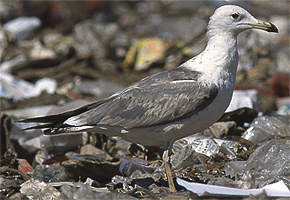 |
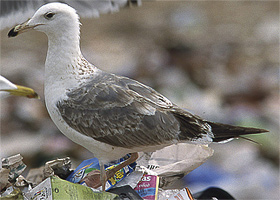 |
|
| Example of a typical 2cy heuglini © Visa Rauste |
Another typical bird from Russia © Visa Rauste |
Identification criteria. Based on birds seen at Syktyvkar, a number of features are present in the most distinctive and therefore 'characteristic' heuglini. Such birds offer perhaps the best hope and, in this sense, are arguably the most rewarding type to look out for. The features shown by these birds are summarised below.
1. Moult. A complete renewal of plumage in their first winter is unknown for graellsii and intermedius but is the commonest moult strategy in fuscus. Heuglini sits somewhere between these extremes but the most characteristic birds are rather closer to fuscus. Many of the birds observed in summer in Russia have replaced all of their wing coverts and tertials on the wintering grounds and some have also replaced some or all of their secondaries and tail feathers. We know of only a single ringed (and hence proven) intermedius that has replaced secondaries over its first winter (a bird seen by Rik Winters).
A minority (<10%) of heuglini replaces primaries over their first winter. We have seen a very small number of heuglini (<5 individuals in total from our combined experience) that have replaced all primaries during their first winter. From this we conclude that, though rare, heuglini can follow a moult strategy equivalent to that of the typical fuscus. This is not known in proven (i.e. ringed) graellsii or intermedius. Some heuglini replace only a small number of primaries over their first winter and may arrest or suspend this moult before they return north. Interestingly, this replacement is not necessarily in a logical sequence, as shown by this 2cy bird and this 2cy bird. The same seems to apply to the secondaries. Sample sizes are very small so for the moment it would be unwise to attach too much significance to this, but what we can say is that in those heuglini which moult a small number of primaries or secondaries over their first winter, what appears to be an unusual moult sequence is quite frequent.
An important point to note is that these observations are based on the appearance of birds observed in the summer of their second calendar year. As we have not actually observed the moult process over the first winter, we are merely inferring the sequence based on the generations of feathers present on birds when they return north in the spring or summer.
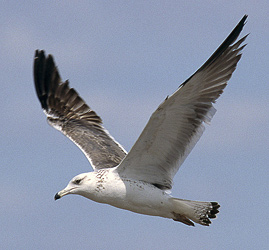 |
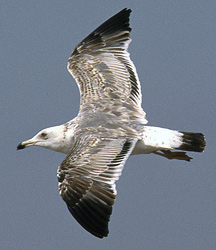 |
|
| 2cy Heuglin's Gull with only the outer primaries renewed... © Visa Rauste |
... and with only the inner primaries retained © Visa Rauste |
2. Upperparts. The most distinctive heuglini show pale 'powder blue' scapulars and wing coverts during the spring and early summer of their second calendar year. These feathers are often very simply patterned (perhaps only a dark shaft streak) and therefore appear adult-like. It is very difficult to be sure about the age of these, but almost certainly many birds have some third generation feathers amongst the second generation ones. The most advanced 2cy heuglini can look more similar to 3cy graellsii.
3. Head and body. The head and body of heuglini is often very white, with streaking restricted to a neat necklace on the lower, rear neck.
4. Jizz. Compared to graellsii and intermedius, many heuglini look rather elegant, with a small head, long, contourless bill, long neck and long legs. This combination of features can give some heuglini more than a passing resemblance to cachinnans. This resemblance is heightened by the white head and body as well as, in some individuals, the scapular and covert pattern. Long call, the darkness of the inner primaries, the timing of the winter moult and the timing of the complete moult in summer are the safest ways to avoid confusion of some heuglini with some cachinnans. As in all gulls, the structure of heuglini can be variable so a candidate lacking cachinnans-like jizz should not necessarily be ruled out.
5. Underwing. Many heuglini have a striking white underwing. Finely barred auxiliaries is a feature often observed in those heuglini which have some dark markings on the underwing.
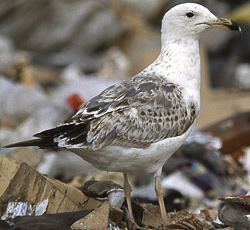 |
 |
|
| 2cy Heuglin's Gull in Russia... © Visa Rauste |
... and 2cy graellsii LBBG in the Netherlands © Ruud Altenburg |
Can these criteria be used with confidence to identify heuglini away from Russia? Certainly large numbers of birds showing combinations of these features are seen annually in Finland. This amounts to overwhelming evidence that these Finnish birds are heuglini (it seems extremely unlikely that they are all western birds showing heuglini-like features). So, using this rationale we can argue with some confidence that heuglini is a very regular visitor to Finland; this of course is now widely accepted amongst Finnish ornithologists. Nonetheless, it is important to distinguish between this weight of numbers approach to determining the occurrence of heuglini outside of its 'normal' range and that needed for the identification of individual birds. The presence in Finland of large numbers of birds matching those seen in Russia means that here, at least in terms of establishing the status of heuglini, there is less need to be concerned with the identification of individual birds (the identification of no single individual is going to affect perceptions of the status of heuglini). However, in the UK and other countries bordering the North Sea, where only the occasional heuglini is likely to appear, it is the individual birds that will be the focus of attention.
It should be very obvious from the range of birds we have illustrated on this site that it is extremely difficult to define failsafe criteria that can be used to identify individual heuglini in W Europe. There is sufficient variation in the western Lesser Black-backed Gulls that it is possible to find individuals that closely match heuglini and there remains the concern that some may perfectly match heuglini. Certainly a number of the birds seen in 2006 in the Netherlands are a close match, but they are unringed and so their origin is unknown. Certain individuals can present currently intractable problems: this bird could be a pale and exceptionally advanced intermedius, an extremely pale fuscus or an example of the most advanced type of heuglini. Because of the problems thrown up by birds such as this, we should conclude that at the current time it is not possible to be 100% certain with the identification of any individual out-of-range bird. However, it is difficult to reconcile this cautious view with the intuitive sense that birds such as the Kiberg gull should be heuglini; this bird is as far from the typical graellsii or intermedius as you could find. In fact this individual is extreme even for heuglini, as it is one of a very small minority of individuals that moult in a full set of new primaries over their first winter. While based on the appearance of the birds seen in Russia we might argue that this bird is a heuglini, the chance of one showing this combination of plumage and moult features appearing in W Europe is small.
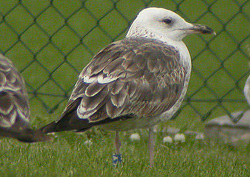 |
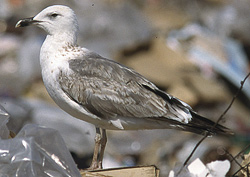 |
|
| 2cy intermedius LBBG in the Netherlands... © Ruud Altenburg |
... and 2cy Heuglin's Gull in Russia © Visa Rauste |
We are now beginning to expand this discussion into one that relies on probabilities and percentages. It was never our attention to do this with the web site; rather, a more statistically-based analysis is something that we might hope to do as part of a future paper on the identification of 2cy heuglini. There are a number of more quantitative things that we could usefully do as part of such a paper. One obvious thing would be to assess statistically the data that we have on the commencement of heuglini's complete moult, a moult which starts in the summer of the second calendar year and is indicated by the onset of primary moult. Our data on heuglini, relative to those published by Stewart (2006) for British graellsii, suggest that heuglini may start this complete/primary moult rather late. However, even if statistically significant differences in the average timing of primary moult exist, there are severe limitations on the value of this for the identification of individual birds. First, a formal significance test would tell us only whether there are 'average' or 'population-level' differences between the taxa. This is interesting and useful to know from a population point of view, but variation around population averages means that some individuals could have a moult timing that could equally be shown by heuglini or graellsii. Hence, average differences may prove to be of little help in the identification of individual birds. There are also some more fundamental problems. Peter Stewart's data are for SW England but graellsii in the Netherlands, for example, commence their moult at a different time to British birds. This raises the question of whether, and how, graellsii populations should be subdivided within such statistical tests, in order to recognise geographic variation. Finally, there remains the problem that an individual out-of-range bird may not moult in a normal way. Consequently, while there may be insights to be gained from a more rigorous analysis of the data we have on the timing of heuglini's complete moult, we need to be extremely careful about how this might be used in identification.
To return to the aim of the web site, we hope that we have been able to illustrate the range of plumages and moult patterns shown by birds belonging to the Lesser Black backed Gull taxa. In so-doing we hope we have emphasised the features that are more typically associated with heuglini than graellsii, intermedius or fuscus. We would like to reiterate our request for photographs of ringed individuals. If at all possible, photographs should show the bird in different poses and show different feather groups; this will allow us to calculate moult scores, etc. Only with data on ringed birds can we hope to build up a full picture of the extent of variation shown by each taxon. It is of course only when we are confident about where the extremes of each taxon lie that we can be confident about the identification of individual out-of-range birds. Please check this overview of all ringed 2cy graellsii and intermedius to see if you can contribute any pictures.
| Back |